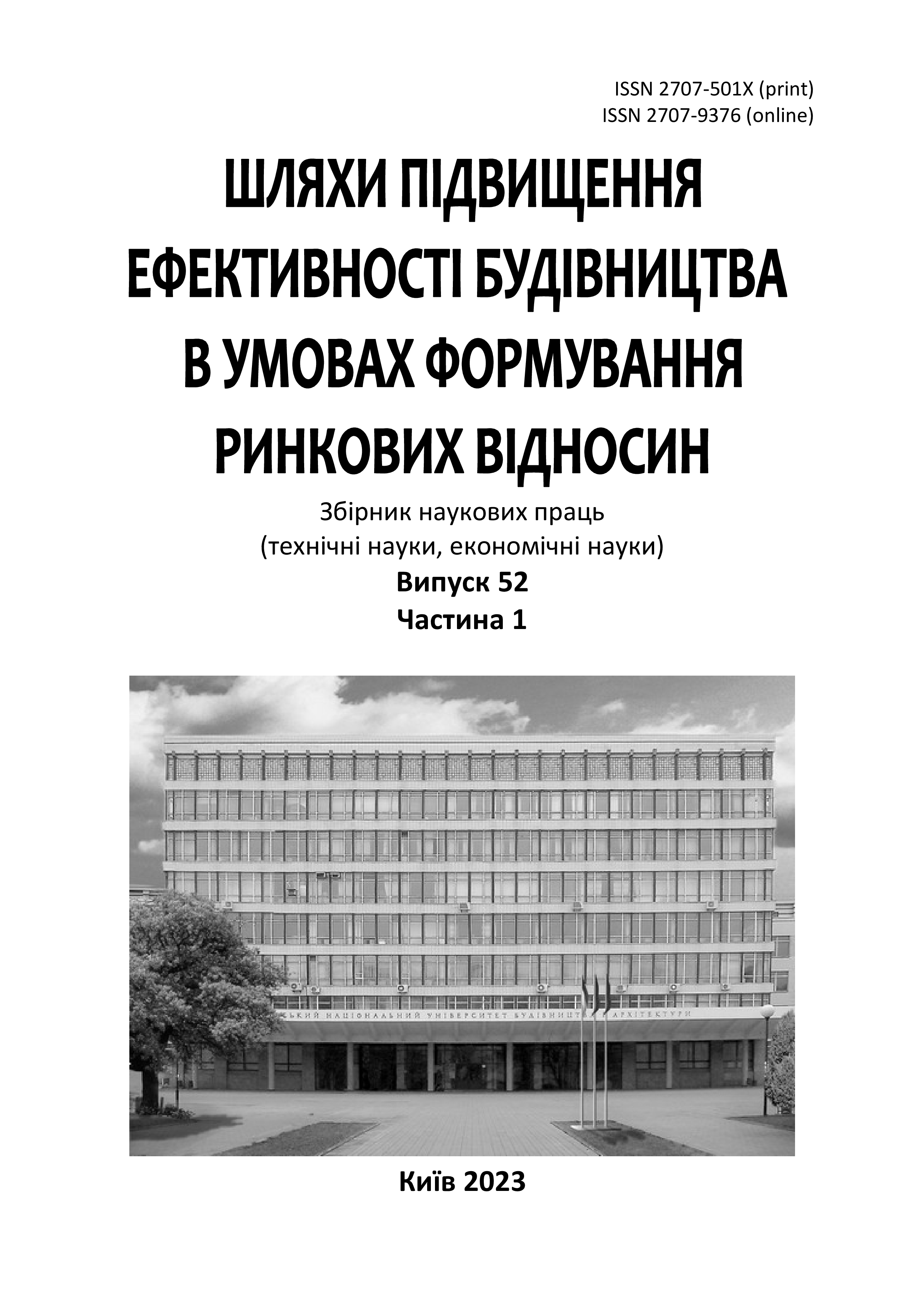Dispersed-reinforced concretes and mixtures with mineral and organic fibers
DOI:
https://doi.org/10.32347/2707-501x.2023.52(1).181-195Keywords:
discrete fibers, composite materials, elastic modulus, reinforcement, propertiesAbstract
Problem Statement and Relevance. The article addresses the development and research of composite materials reinforced with discrete fibers of low (organic) and high (mineral) elastic modulus, corresponding to E = 400-1000 MPa and E = 40000-60000 MPa, respectively. The use of discrete fiber reinforcement technology is considered a solution to enhancing the strength and reducing deformation characteristics of materials based on mineral binders. In the United States, Japan, and Western European countries, the production of composites reinforced with discontinuous fibers of organic and mineral origin is well-established. In France and Germany, scientific and industrial organizations have been established for the development of reinforced composite materials for aerospace, engineering, and construction industries. The introduction of discrete reinforcement technology in the production of reinforced concrete products simplifies the manufacturing process, especially for thin-walled structures. Calculations show that 1 ton of discrete fibers can replace up to 5 tons of steel. The article aims to develop and discover composite materials reinforced with discrete fibers with low and high modulus. Conclusions. Based on the results, the hypothesis of expanding the range of physical and mechanical properties of composite materials based on mineral binders by introducing a mixture of discrete organic and mineral fibers with high and low modulus is relevant and promising in the full development of construction material production technology. Organic fibers with a modulus of elasticity of 400-1000 MPa increase bending strength and dynamic load resistance (impact toughness) to 8-12 MPa and 20-29 kJ/m2, respectively. Discrete fibers of mineral origin with a modulus of elasticity of 40000-60000 MPa increase tensile strength by 2.5-3 times and compressive strength by 1.2-1.25 times. Impact strength and bending strength significantly exceed those of non-reinforced composites, reaching values of 38-50 kJ/m2 and 12-14 MPa. Fiber parameters depending on matrix properties and composite design indicators. In our studies, fiber length ranges from 18-51 mm with organic fiber content of 0.6-1.2% and glass fiber content of 4.1-4.5%. These parameters allow increasing tensile and compressive strength of composite materials reinforced with a fiber mixture by 2.2-3.0 and 1.2-1.3 times, respectively. A promising method is the preparation of samples and products by spraying (shotcrete method), achieving effects at lower parameters. The technology of applying coatings by spraying (shotcrete method with the CETI-487B ejector-type machine) includes a working mode selected by shotcreting a portable metal shield: the amount of shotcrete mixture supplied, water, compressed air pressure, consistency of the solution, distance from the installation to the workplace, and from it to the shotcreting surface in vertical and horizontal directions. In the manufacture of samples, this method allows introducing up to 8-10% of discrete fibers (by the mass of the binder) compared to 3-4% by conventional forming methods.
References
Solodkyy S., Turba Y. Improvement of the fracture crack resistance of the dispersionreinforced concrete. 19. Iinternationale Baustofftagung. IBAUSIL. Weimar, 2015. Band 2. P.2-1075-2-1082.
Turba Y., Solodkyy S. Crack resistance of concretes reinforced with polypropylene fiber. Lecture Notes in Civil Engineering. 2020. Vol. 100: Proceedings of 2nd International scientific conference on EcoComfort and Current issues of civil engineering EcoComfort 2020, Lviv; Ukraine, 16–18 September 2020. P. 474–481.
Sanytsky M. et al. Nanomodified Ultra High-Performance Fiber Reinforced Cementitious Composites with Enhanced Operational Characteristics. International Conference Current Issues of Civil and Environmental Engineering. Lviv-Košice–Rzeszów. – Cham: Springer Nature Switzerland, 2023. Р. 362-371.
Derevianko V.N., Kondratieva N.V., Hryshko H.M., Sanitskiy М.A. Modelling the Mechanism of Mineral-Binders’ Hydration Processes in a Macro–Micro–Nanosystem. Наносистеми, наноматеріали, нанотехнології. 2020. Том 18. Вип. 1. С. 107 – 124. DOI: https://doi.org/10.15407/nnn.18.01.107. 2020.
Derevianko V., Kondratieva N., Volkova V., Hryshko H. Nanomodification of mineral binders. IOP Conference Series: Materials Science and Engineering. 2021. Vol.1162 (012001). P. 1–14. doi:10.1088/1757-899X/1162/1/012001.
Derevianko V., Kondratieva N., Volkova V., Hryshko H. Technology of Production of Binder Modifying Nanoadditives. Materials Science Forum: Actual Challenges in Materials Science and Processing Technologies II. Switzerland: Trans Tech Publications Ltd., 2021. Vol. 1045. Р. 50–58. https://doi.org/10.4028/www.scientific.net/MSF.1045.
Derevianko V.N., Kondratieva N.V., Hryshko H.M., Moroz V.Y. Nanomodifying of Gypsum Binders with Carbon Nanotubes. Наносистеми, наноматеріали, нанотехнології. 2022. Том 20. Вип. 1. С. 127 – 144. https://www.imp.kiev.ua/nanosys/media/pdf/2022/1/nano_vol20_iss1_p0127p0144_2022.pdf.
Derevianko V., Kondratieva N., Hryshko H. Study of impact factors and the mechanism of process of gypsum binder hydration in the presence of nanomodifiers. French-Ukrainian Journal of Chemistry. 2018. Vol. 6 (1). No 1. P. 92 – 100. DOI: https://doi.org/10.17721/fujcV6I1P92-100.
Derevianko V., Kondratieva N., Hryshko H. Structure and properties of calcium sulfate hemihydrate modified with carbon nanotubes. Будівельні матеріали та вироби. 2020. № 1–2 (101). С. 36 – 39. http://ndibmv.kiev.ua/budivelni-materiali-i-virobi-n1-2-za-2020-r.
Krivenko P.V. et al. Complex multifunctional additive for anchoring grout based on alkali-activated portland cement. IOP Conference Series: Materials Science and Engineering. – IOP Publishing, 2020. Т. 907. № 1: 012055.
Downloads
Published
How to Cite
Issue
Section
License

This work is licensed under a Creative Commons Attribution 4.0 International License.
Authors who publish with this journal agree to the following terms:
- Authors retain copyright and grant the journal right of first publication with the work simultaneously licensed under a Creative Commons Attribution License that allows others to share the work with an acknowledgement of the work's authorship and initial publication in this journal.
- Authors are able to enter into separate, additional contractual arrangements for the non-exclusive distribution of the journal's published version of the work (e.g., post it to an institutional repository or publish it in a book), with an acknowledgement of its initial publication in this journal.
- Authors are permitted and encouraged to post their work online (e.g., in institutional repositories or on their website) prior to and during the submission process, as it can lead to productive exchanges, as well as earlier and greater citation of published work (See The Effect of Open Access).

